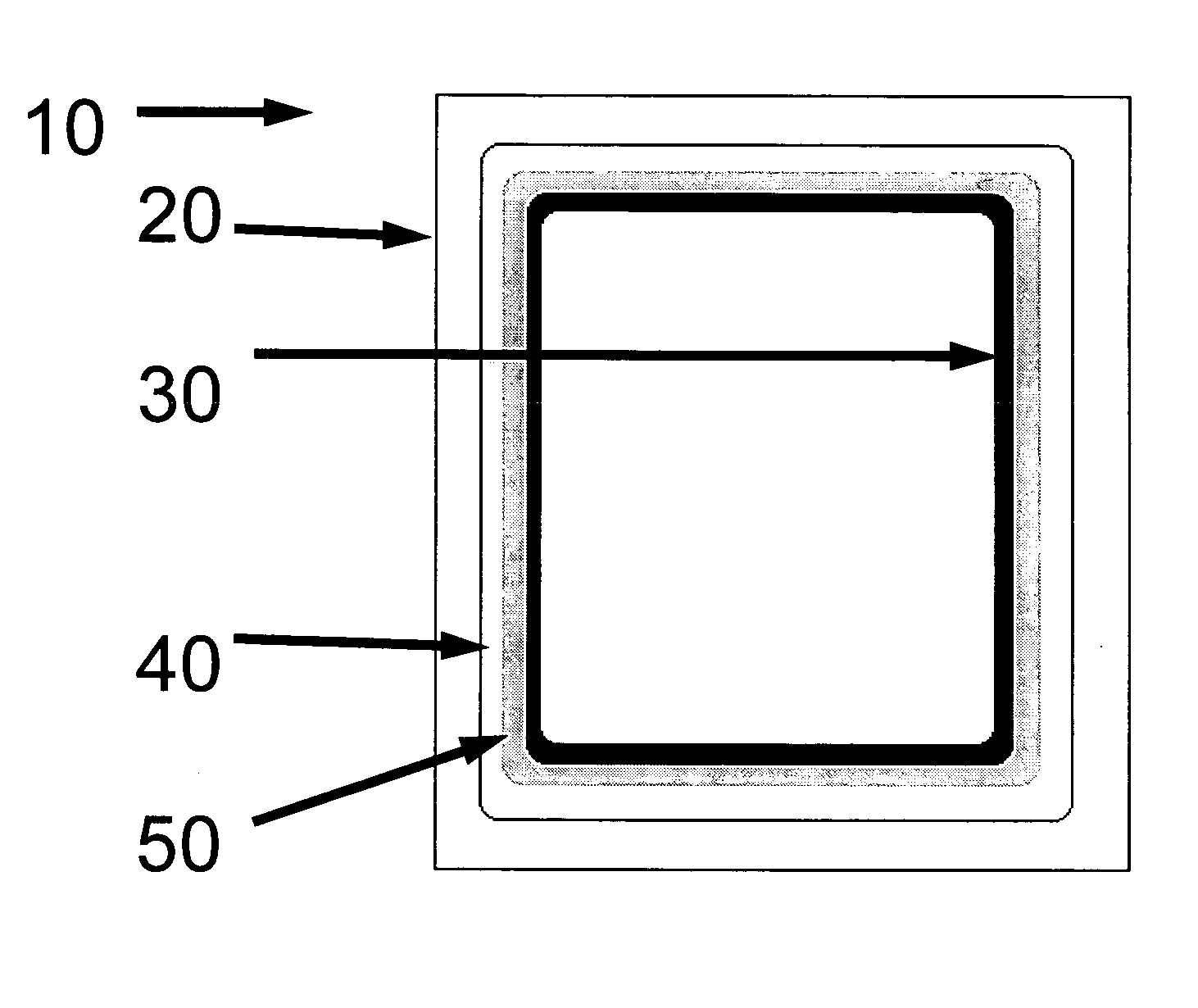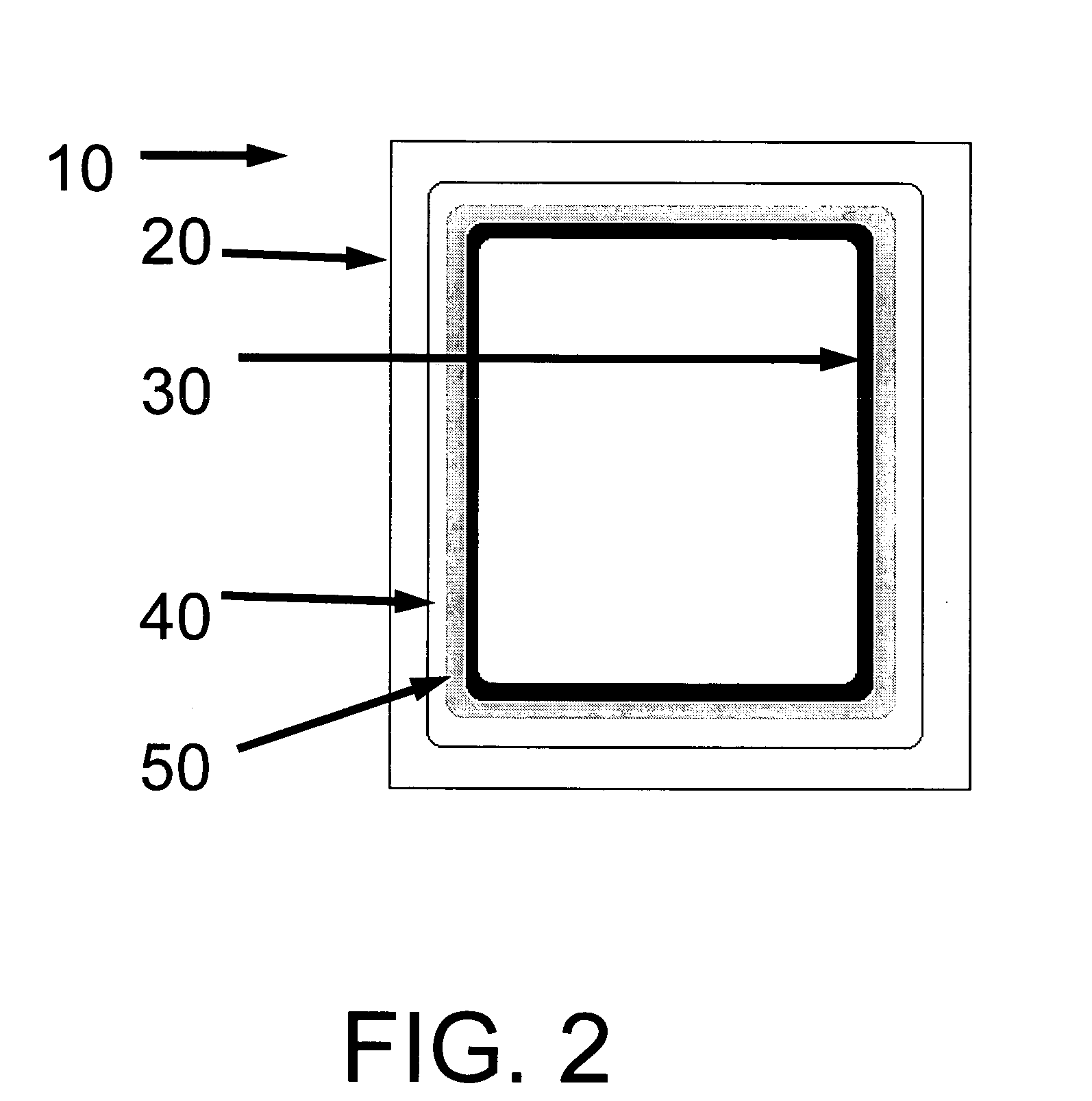Seal for light emitting display device, method, and apparatus
a technology of light-emitting display and sealing process, which is applied in the manufacture of electrode systems, electric discharge tubes/lamps, discharge tubes luminescnet screens, etc., can solve the problems of difficult development of a sealing process to hermetically seal a light-emitting display, and the electrodes and organic layers located therein are susceptible to degradation
- Summary
- Abstract
- Description
- Claims
- Application Information
AI Technical Summary
Benefits of technology
Problems solved by technology
Method used
Image
Examples
example 1
Frit Compositions (Glass Portions)
[0108]In a first example, a series of frit compositions were prepared comprising various combinations of components. The composition of each inventive sample is set forth in Table 3 below. All of the amounts detailed in Table 3 refer to mole percent.
TABLE 3Glass CompositionsSample (mole %)ComponentABCDEFGHIJKSiO262655956686857.512.71000B2O322.52220.52222222728.43000Al2O34447424001.01.0CuO8881400801100Fe2O31.511.511.121.53.25200TiO20.500.5000.50.5001.01.0Li2O10100.80.510000V2O50.500.501.120.53.25247.546.6Na2O00003300000ZnO005000052.445017.6K2O00000000000Sb2O300000000023.57.4P2O50000000002726.5WO300000000000Bi2O300000000000
[0109]The example compositions detailed in Table 3 above can substantially match the CTE of an Eagle glass substrate without addition of a CTE matching filler.
example 2
Preparation of Inventive Glass Frit Powder
[0110]In a second example, a frit composition was prepared by combining the components of Inventive Sample A described in Table 3 above. The resulting mixture was heated to about 1,550° C. for approximately 6 hours to melt the components.
[0111]The hot glass mixture was subsequently fractured by pouring into cold water. The fractured glass pieces were crushed to 325 mesh and then wet milled to an average particle size of approximately 1.9 micrometers.
example 3
Application of Frit Composition (Prophetic)
[0112]In a third example, a frit paste can be prepared for application to a substrate. Initially, a 2 wt. % binder solution can be prepared by dissolving a T-100 ethylcellulose binder, available from Hercules, Inc. (Wilmington, Del., USA) in TEXANOL®, an ester alcohol, available from Eastman Chemical Company (Kingsport, Tenn., USA). A frit paste can then be prepared by mixing the following components: 19.09 grams of the T-100 / TEXANOL solution prepared above, 55.33 grams of the glass powder prepared in Example 2, and 0.61 grams of an OC-60 wetting agent, available from Dexter Chemical, L.L.C. (Bronx, N.Y., USA). The resulting frit paste can be dispensed onto an Eagle borosilicate glass substrate (Corning Inc., Corning, N.Y., USA), in a square pattern. The applied frit can then be sintered to the Eagle substrate at 700° C. for approximately 2 hours in a nitrogen environment.
[0113]Additional frit paste can be applied at the four corners of the...
PUM
| Property | Measurement | Unit |
|---|---|---|
| Polymeric | aaaaa | aaaaa |
| Coefficient of linear thermal expansion | aaaaa | aaaaa |
Abstract
Description
Claims
Application Information
 Login to View More
Login to View More - R&D
- Intellectual Property
- Life Sciences
- Materials
- Tech Scout
- Unparalleled Data Quality
- Higher Quality Content
- 60% Fewer Hallucinations
Browse by: Latest US Patents, China's latest patents, Technical Efficacy Thesaurus, Application Domain, Technology Topic, Popular Technical Reports.
© 2025 PatSnap. All rights reserved.Legal|Privacy policy|Modern Slavery Act Transparency Statement|Sitemap|About US| Contact US: help@patsnap.com



